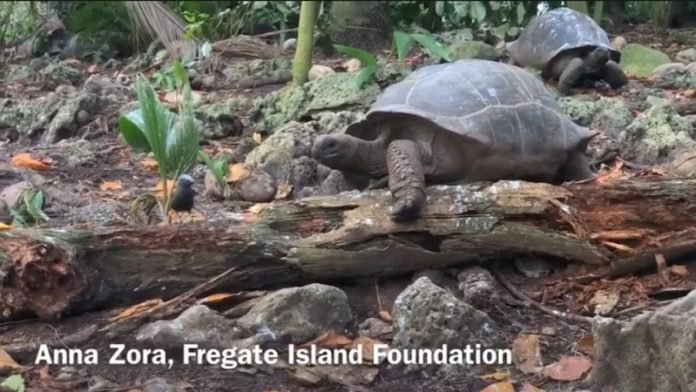
A predator doesn’t need to have the quickest speed or reflexes to catch a bird.
In a paper published in the journal Current Biology, researchers report the first documented evidence of a tortoise going in for the kill: biting the head of, killing, and eating a tern chick.
This is the first time such behavior has been captured on camera, and it’s likely not the only case of tortoise bird slaughter that’s occurred.
“I couldn’t believe what I was seeing,” says corresponding author Justin Gerlach (@jstgerlach), Director of Biology Studies at the University of Cambridge’s Peterhouse College. “It was horrifying and amazing at the same time.
In the video—filmed in the woodlands of Frégate Island in the Seychelles, an archipelago off the coast of East Africa in the Indian Ocean—an adult female tortoise makes a direct beeline at normal walking pace toward its target: a tern chick stranded on a log.
https://youtu.be/4RhJyiF4gMg
“It was looking directly at the tern and walking purposefully toward it. This was very, very strange, and totally different from normal tortoise behavior,” says Gerlach.
Slow and steady, the tortoise stalks closer. When it gets within biting distance, it reaches out with its mouth open.
The chick tries to defend itself by pecking at the tortoise, but its efforts are futile. Once the chick reaches the end of the log with nowhere else to go, the tortoise crushes its jaws directly on the head of the chick.
The limp chick plummets from the log. The tortoise climbs down and swallows it whole. The entire process takes seven minutes.
Though people often associate the tortoise’s speed—or lack thereof—with simple and benevolent herbivorous habits, this isn’t the first report of tortoises consuming meat or calcium-rich animal parts like bones or shells in the wild.
“But previously, it’s always been impossible to tell if the tortoise had directly killed the animal, or if it had just happened to sit down on one and find it conveniently squashed dead,” says Gerlach. “Why turn down a bit of free protein?”
This video taken by Anna Zora, the island’s deputy conservation and sustainability manager, offers some of the first definitive evidence of a deliberate, planned attack.
For one, the tortoise approaches the chick with its jaws open and tongue retracted, which Gerlach says is typical for aggressive tortoise behavior—like the tern was something to be killed, rather than simply something to eat.
In addition, the tortoise appeared to have experience in capturing chicks on logs. Terns are tree-nesting birds.
When chicks fall, their instinct is to avoid the ground at all costs: this is likely why the chick remained on the log even while the tortoise crept closer. Gerlach says, “It looked to me like that individual had hunted successfully before; it seemed to know what it was doing.”
While this tortoise appears to be an experienced hunter, questions remain about how many tortoises hunt, how often they do it, how much nutrition they get from it, and if this is happening in other locations too.
“Could we be seeing a population of tortoises that is developing a new type of behavior with evolutionary implications, or is it just an interesting observation at the moment?” Gerlach wonders.
He suspects that the conservation efforts on Frégate Island could be part of what is driving the emergence of this unusual behavior.
Though seabird and tortoise populations have been on the decline for the past few hundred years, efforts on the island have revived the population of both to create a very unique combination of high bird and high tortoise populations. Gerlach says, “We’re recreating conditions for natural behaviors that people haven’t seen for hundreds of years.”
It’s also possible that tortoises’ palates aren’t just limited to birds. As long as it’s slow enough to catch, why not eat it? “There’s a lot of stories of tortoises eating snail shells for the calcium to make their own skeletons, but I don’t see why they couldn’t also systemically eat snails, too,” he says.
Despite all these unknowns, Gerlach says one thing is certain: “It’s clear that they enjoy eating terns. Compared to the ease of eating plants, they’re going to quite a lot of trouble.”



